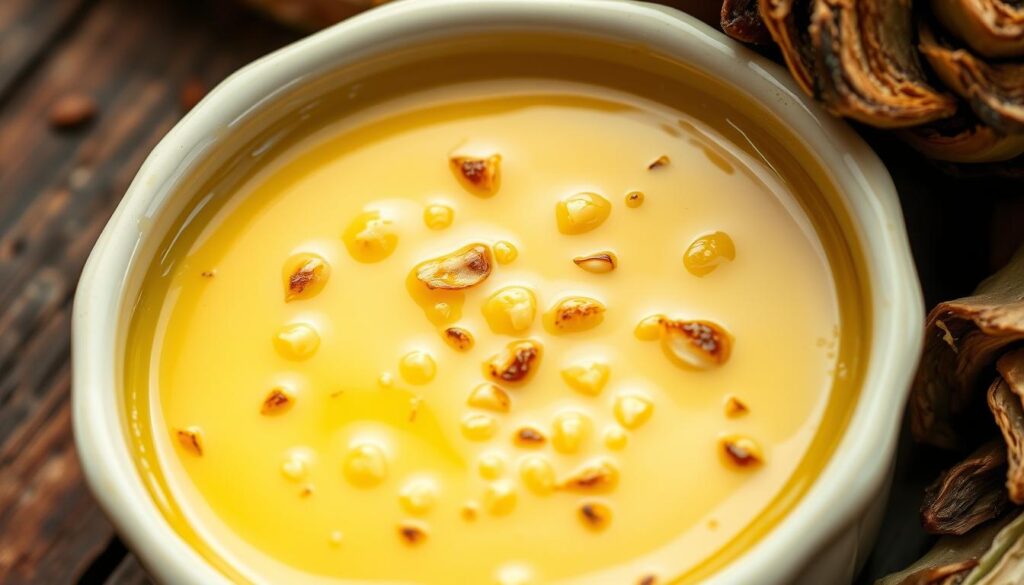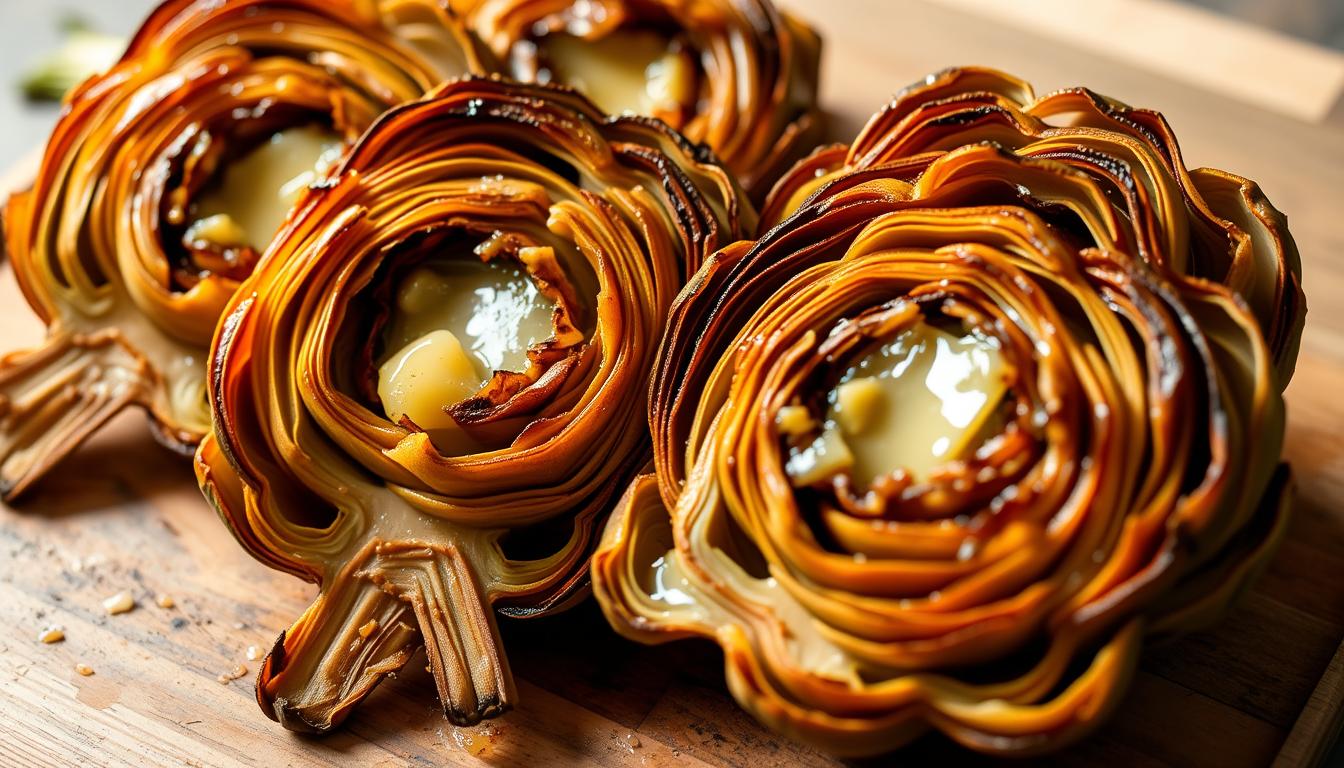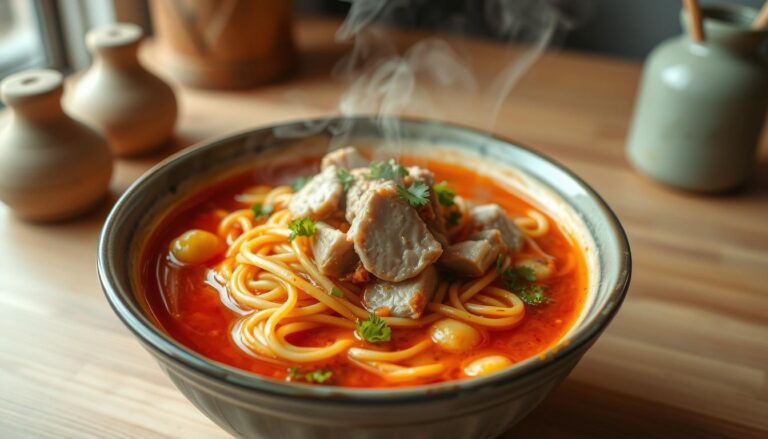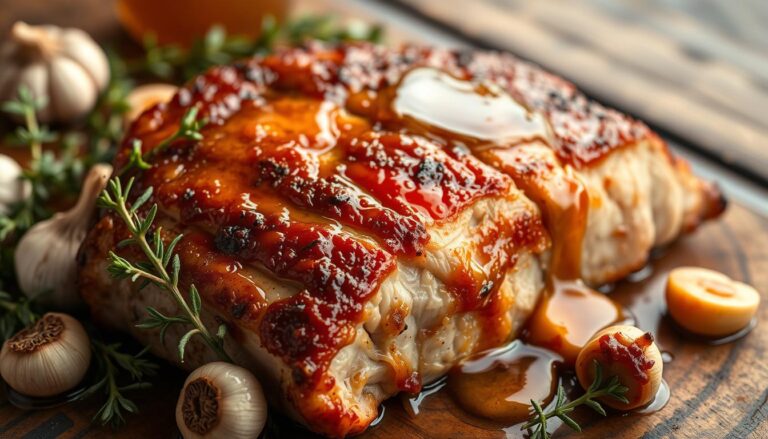Roasted Artichokes with Garlic Butter: Easy Recipe
There’s something magical about transforming simple ingredients into a dish that feels like a warm hug. Picture this: golden artichokes, their earthy sweetness deepened by the oven’s heat, paired with a velvety sauce that dances between rich and zesty. It’s the kind of meal that turns a Tuesday night into a celebration.
This recipe isn’t just about flavor—it’s about connection. Whether you’re cooking for family or treating yourself, these oven-baked beauties reward patience with tender leaves perfect for dipping. Fresh garlic and bright lemon cut through the richness of melted butter, creating a harmony that’ll make your taste buds sing.
What makes it truly special? Simplicity. With minimal prep and about 40 minutes of roasting time, even beginners can master this dish. You’ll learn how to trim the veggie like a pro and balance flavors like a seasoned chef. Let’s dive into the details so you can create a meal that’s as memorable as it is delicious.
Key Takeaways
- Oven-roasting enhances artichokes’ natural sweetness while keeping prep straightforward
- Fresh garlic and lemon add vibrant contrast to rich, herb-infused butter
- Tender leaves become edible spoons for the signature dipping sauce
- Requires basic kitchen tools and about an hour from start to finish
- Ideal for appetizers or as a standout side dish at gatherings
Overview and Benefits of Roasted Artichokes
Ever wonder how a humble veggie becomes the star of your dinner table? When prepared right, artichokes transform into a showstopper dish that balances rustic charm with gourmet appeal. Their layered leaves soak up flavors like edible sponges, while the heart delivers a meaty texture worth savoring.
Why You’ll Love This Recipe
This method lets the artichoke shine without fuss. Cutting them in half speeds up cooking time, while a drizzle of olive oil caramelizes the edges for subtle sweetness. You get crispy-tender leaves in under an hour—no fancy tools required.
Removing the fuzzy choke before roasting eliminates guesswork during meals. Guests can dive straight into pulling apart leaves and dipping them in sauce. It’s interactive dining at its best, perfect for casual gatherings or solo indulgence.
Nutritional and Flavor Highlights
Beyond taste, these veggies pack a nutritional punch. A single serving offers 7 grams of fiber and antioxidants like vitamin C. The olive oil not only enhances flavor but also helps your body absorb these nutrients more effectively.
Roasting unlocks earthy notes that steaming can’t match. Paired with zesty lemon and aromatic herbs, each bite feels both wholesome and decadent. Stay tuned—we’ll break down the trimming process and seasoning tricks next.
Essential Ingredients & Prep Tips
Great dishes start with quality ingredients—this recipe is no exception. Proper preparation ensures your artichokes stay vibrant and flavorful from cutting board to plate.
Choosing Fresh Artichokes and Herbs
Look for globe artichokes with tightly packed leaves and squeaky stems. Avoid any with dry tips or brown spots. Pair them with bright, fragrant herbs like thyme or parsley—their oils intensify during roasting.
Use olive oil with a fruity profile to enhance earthy flavors. Coarse salt helps draw out moisture for better texture. Trim the stem to 1 inch and slice off the top quarter to expose inner leaves evenly.
Preventing Browning with Lemon Juice
Artichokes oxidize quickly. Fill a bowl with cold water and 2 tablespoons lemon juice immediately after cutting. Submerge each half cut-side down for 5 minutes—this acid bath preserves color and freshness.
Pat them dry before brushing with oil and seasoning. This step also primes the leaves for optimal dipping later. Remember: proper prep means your artichokes will look as stunning as they taste.
Step-by-Step Instructions for Roasting Artichokes
Unlock the full potential of your artichokes with precise preparation and roasting techniques. Follow these straightforward steps to achieve tender leaves and a perfectly caramelized heart every time.
Preparing and Trimming the Artichokes
Start by rinsing your artichokes under cold water. Use a sharp knife to slice off the top third, removing any thorny tips. Peel away the tough outer leaves until you reach the pale yellow layers.
Cut each artichoke in half lengthwise. Scoop out the fuzzy choke with a spoon, creating a smooth cavity. Immediately rub the exposed surfaces with lemon juice to prevent browning.
Roasting Process and Timing Guidelines
Preheat your oven to 400°F. Arrange the halves cut-side up in a baking dish. Drizzle generously with olive oil and sprinkle with coarse salt and cracked black pepper.
Roast for 35-40 minutes until the edges turn golden and the stems feel fork-tender. For extra crispiness, broil for 2-3 minutes at the end. Let rest 5 minutes before serving—this allows flavors to settle beautifully.
Pro tip: Keep your knife blade angled slightly downward when trimming to avoid damaging the heart. Proper cutting technique ensures even cooking and stunning presentation.
Mastering roasted-artichokes-with-garlic-butter
The secret to unforgettable artichokes lies in mastering the sauce. A well-crafted garlic butter transforms simple roasted halves into a dish that lingers on the palate. Let’s explore techniques to balance pungent garlic with rich dairy without overpowering the star ingredient.

Crafting the Perfect Garlic Butter Blend
Start with softened butter for easy mixing. Use 3 tablespoons per artichoke half—this ratio ensures each leaf gets enough flavor. For every ½ cup of butter, add 4 minced cloves. Fresh garlic works best, but roasted cloves add smoky depth.
Prevent burnt garlic by gently melting butter in a pan over low heat. Stir with a spoon until fragrant—about 2 minutes. Microwaving in 15-second bursts also works. Either way, watch closely to avoid bitter flavors.
During prep, test your blend’s consistency. It should coat the back of a spoon without separating. For extra richness, fold in garlic confit paste. This kitchen hack intensifies flavor while keeping the sauce velvety.
Drizzle warm butter over roasted halves just before serving. The heat opens the leaves, letting the sauce seep into every layer. Adjust lemon juice or herbs to taste—your kitchen, your rules.
Serving Suggestions and Reheating Tips
Transform your roasted artichokes from kitchen staple to showstopper with smart plating and reheating know-how. These final touches ensure your dish remains vibrant from first bite to leftovers.
Creative Presentation Ideas
Arrange artichoke halves on a slate board or rustic platter. Tuck fresh artichokes alongside lemon wedges and rosemary sprigs for contrast. “Edible centerpieces turn meals into experiences,” says chef Laura Bennett. Sprinkle salt black pepper flakes over the top for visual texture.
Serve with small bowls of lemon juice-spiked aioli or tahini sauce for dipping variety. For gatherings, label each sauce with chalkboard tags—guests love customizing flavors. Add edible flowers like nasturtiums for pops of color that prevent browning concerns.
How to Reheat Without Losing Flavor
Revive leftovers by reheating at 375°F for 8-10 minutes. Place roasted artichoke halves in a baking dish with ¼ cup water to maintain moisture. Cover loosely with foil to trap steam while crisping edges.
Mix leftover garlic cloves into softened butter and brush over each artichoke half before warming. This refreshes herbal notes without overpowering. Avoid microwaving—it turns tender leaves rubbery.
For next-day lunches, pack cooled roasted artichokes in airtight containers layered with damp paper towels. A squeeze of lemon juice before sealing helps prevent browning during storage.
Conclusion
Mastering this dish proves elegance lies in simplicity. You’ve learned to trim outer leaves with kitchen shears, rub cut surfaces with lemon juice to prevent browning, and roast artichoke halves in a baking dish until caramelized. Each step—from seasoning with salt and black pepper to infusing garlic butter—builds layers of flavor.
Quality tools make all the difference. A sharp knife ensures clean cuts, while proper kitchen shears remove tough stems effortlessly. Roasting at high heat transforms humble veggies into tender artichoke halves with crispy edges worth savoring.
Don’t hesitate to experiment. Add extra lemon juice for brightness or double the black pepper for heat. Share your creations—this recipe turns first-timers into confident cooks. The golden baking dish presentation alone deserves applause.
Remember: soaking trimmed pieces in acidic juice stops browning, keeping your artichoke halves vibrant. Now that you’ve got the technique, relish each dip into herb-speckled garlic butter. Simple enough for weeknights, sophisticated enough for guests—this dish delivers every time.
FAQ
How do I pick the best fresh artichokes for roasting?
Look for firm, heavy artichokes with tightly packed leaves. Avoid ones with dry stems or brown spots. Freshness ensures tender results after roasting.
Why is lemon juice used during preparation?
Lemon juice prevents browning by slowing oxidation. Rubbing it on cut surfaces keeps the artichokes vibrant while enhancing their natural tangy flavor.
What’s the easiest way to trim an artichoke?
Use kitchen shears to snip thorny leaf tips. Slice off the top third, then trim the stem. Halve vertically and scoop out the fuzzy choke with a spoon.
How long does roasting take, and at what temperature?
Roast at 400°F (200°C) for 25–35 minutes. The leaves should pull off easily, and the heart should be fork-tender when done.
Can I substitute dried garlic for fresh cloves?
Fresh garlic cloves are ideal for deeper flavor infusion. If using dried, reduce the quantity by half to avoid overpowering the dish.
What’s a creative way to serve roasted artichokes?
Drizzle with extra garlic butter and garnish with parsley or grated Parmesan. Pair with grilled meats or serve as a shareable appetizer with dipping sauces.
How do I reheat leftovers without drying them out?
Wrap in foil and warm in a 350°F (175°C) oven for 10–15 minutes. Add a splash of water or broth to maintain moisture.







